Powders Synthesized from Calcium Chloride and Mixed-Anionic Solution Containing Orthophosphate and Carbonate Ions
Abstract
1. Introduction
2. Materials and Methods
3. Results and Discussion
4. Conclusions
Author Contributions
Funding
Data Availability Statement
Acknowledgments
Conflicts of Interest
References
- Andrianov, N.T.; Balkevich, V.L.; Belyakov, A.V.; Vlasov, A.S.; Guzman, I.Y.; Lukin, E.S.; Mosin, Y.M.; Skidan, B.S. Chemical technology of ceramics: Textbook. In Handbook for Universities; Guzmanm, I.Y., Ed.; Rif Stroymaterialy LLC: Moscow, Russia, 2012; 496p, ISBN 978-5-94026-01966. (In Russian) [Google Scholar]
- Butt, Y.M.; Sychev, M.M.; Timashev, V.V. Chemical technology of binder materials. In Textbook for Universities on Spec. “Chemical Technology of Binding Materials”; Timashev, V.V., Ed.; Higher School: Moscow, Russia, 1980; 472p. ill., 22. (In Russian) [Google Scholar]
- Lee, B.; Komarneni, S. (Eds.) Chemical Processing of Ceramics; CRC Press: Boca Raton, FL, USA, 2005; 756p, ISBN 978-0-42911-963-7. [Google Scholar] [CrossRef]
- Gerasimov, M.D.; Latyshev, S.S.; Bogdanov, N.E.; Loktionov, I.O. Review of constructive solutions in the field of grinding mills. In Energy-Saving Technological Complexes and Equipment for the Production of Building Materials: An Interuniversity Collection of Articles; Bogdanov, V.S., Ed.; Volume Issue XVII; Belgorod State Technological University named after V.G. Shukhov: Belgorod, Russia, 2018; pp. 132–146. Available online: https://www.elibrary.ru/item.asp?id=42997967 (accessed on 23 August 2025). (In Russian)
- Shlyakhtin, O.A.; Tretyakov, Y.D. Recent progress in cryochemical synthesis of oxide materials. J. Mater. Chem. 1999, 9, 19–24. [Google Scholar] [CrossRef]
- Kageyama, H.; Ogino, H. (Eds.) Mixed-Anion Compounds; Special Collection: 2024 eBook Collection; Royal Society of Chemistry RSC: Cambridge, UK, 024; 276p, ISBN 978-1-83916-512-2. [CrossRef]
- Lukin, E.S.; Makarov, N.A.; Kozlov, A.I.; Popova, N.A.; Anufrieva, E.V.; Vartanyan, M.A.; Kozlov, I.A.; Safina, M.N.; Lemeshev, D.O.; Gorelik, E.I. Oxide ceramics of the new generation and areas of application. Glass Ceram. 2008, 65, 348–352. [Google Scholar] [CrossRef]
- Lukin, E.S. Modern high-density oxide ceramics with controlled microstructure. Part I. Effect of aggregation of oxide powders on the sintering and microstructure of ceramics. Refractories 1996, 37, 6–14. [Google Scholar] [CrossRef]
- Ring, T.A. Fundamentals of Ceramic Powder Processing and Synthesis, 1st ed.; Elsevier: Amsterdam, The Netherlands; Academic Press, Elsevier: Cambridge, MA, USA, 30 April 1996; ISBN 9780080532196. [Google Scholar] [CrossRef]
- Safronova, T.V.; Putlyaev, V.I.; Filippov, Y.Y.; Shatalova, T.B.; Fatin, D.S. Ceramics Based on Brushite Powder Synthesized from Calcium Nitrate and Disodium and Dipotassium Hydrogen Phosphates. Inorg. Mater. 2018, 54, 195–207. [Google Scholar] [CrossRef]
- Safronova, T.V.; Knot’ko, A.V.; Shatalova, T.B.; Evdokimov, P.V.; Putlyaev, V.I.; Kostin, M.S. Calcium phosphate ceramic based on powder synthesized from a mixed-anionic solution. Glass Ceram. 2016, 73, 25–31. [Google Scholar] [CrossRef]
- Safronova, T.V.; Putlyaev, V.I.; Filippov, Y.Y.; Knot’ko, A.V.; Klimashina, E.S.; Peranidze, K.K.; Evdokimov, P.V.; Vladimirova, S.A. Powders synthesized from calcium acetate and mixed-anionic solutions, containing orthophosphate and carbonate ions, for obtaining bioceramic. Glass Ceram. 2018, 75, 118–123. [Google Scholar] [CrossRef]
- Song, Y.; Hahn, H.H.; Hoffmann, E. The effect of carbonate on the precipitation of calcium phosphate. Environ. Technol. 2002, 23, 207–215. [Google Scholar] [CrossRef]
- Frank-Kamenetskaya, O.; Kol’tsov, A.; Kuz’mina, M.; Zorina, M.; Poritskaya, L. Ion substitutions and non-stoichiometry of carbonated apatite-(CaOH) synthesised by precipitation and hydrothermal methods. J. Mol. Struct. 2011, 992, 9–18. [Google Scholar] [CrossRef]
- Peranidze, K.; Safronova, T.V.; Filippov, Y.; Kazakova, G.; Shatalova, T.; Rau, J.V. Powders Based on Ca2P2O7-CaCO3-H2O System as Model Objects for the Development of Bioceramics. Ceramics 2022, 5, 423–434. [Google Scholar] [CrossRef]
- Golubchikov, D.; Safronova, T.V.; Nemygina, E.; Shatalova, T.B.; Tikhomirova, I.N.; Roslyakov, I.V.; Khayrutdinova, D.; Platonov, V.; Boytsova, O.; Kaimonov, M.; et al. Powder Synthesized from Aqueous Solution of Calcium Nitrate and Mixed-Anionic Solution of Orthophosphate and Silicate Anions for Bioceramics Production. Coatings 2023, 13, 374. [Google Scholar] [CrossRef]
- Safronova, T.V.; Khantimirov, A.S.; Shatalova, T.B.; Filippov, Y.Y.; Kolesnik, I.V.; Knotko, A.V. Powders Synthesized from Solutions of Calcium Chloride, Sodium Hydrogen Phosphate, and Sodium Sulfate for Bioceramics Production. Ceramics 2023, 6, 561–583. [Google Scholar] [CrossRef]
- Rey, C.; Combes, C.; Drouet, C.; Glimcher, M.J. Bone mineral: Update on chemical composition and structure. Osteoporos. Int. 2009, 20, 1013–1021. [Google Scholar] [CrossRef] [PubMed]
- Abe, M.; Costantino, U.; Alberti, G.; Howe, A.T.; Ruvarac, A. Inorganic Ion Exchange Materials; Clearfield, A., Ed.; CRC Press: Boca Raton, FL, USA, 2018; 297p, ISBN 0-8493-5930-9. [Google Scholar]
- Ivanets, A.I.; Shashkova, I.L.; Kitikova, N.V.; Radkevich, A.V.; Davydov, Y.P. Recovery of strontium ions with calcium and magnesium phosphates from aqueous solutions against the background of CaCl2. Radiochemistry 2015, 57, 610–615. [Google Scholar] [CrossRef]
- Berlyand, A.S.; Snyakin, A.P.; Prokopov, A.A. Adsorption capacity of hydroxyapatite for several amino acids and heavy metal ions. Pharm. Chem. J. 2012, 46, 292. [Google Scholar] [CrossRef]
- Bystrov, V.S.; Paramonova, E.V.; Filippov, S.V.; Likhachev, I.V.; Bystrova, A.V.; Avakyan, L.A.; Kovrigina, S.A.; Makarova, S.V.; Bulina, N.V. Features of the Structure and Properties of Hydroxypapatite with Various Cationic Substitutions. In Proceedings of the International Conference “Mathematical Biology and Bioinformatics”; Lakhno, V.D., Ed.; IMPB RAS: Pushchino, Russia, 2024; Volume 10, Paper No. e11. (In Russian) [Google Scholar] [CrossRef]
- Tite, T.; Popa, A.-C.; Balescu, L.M.; Bogdan, I.M.; Pasuk, I.; Ferreira, J.M.F.; Stan, G.E. Cationic Substitutions in Hydroxyapatite: Current Status of the Derived Biofunctional Effects and Their In Vitro Interrogation Methods. Materials 2018, 11, 2081. [Google Scholar] [CrossRef]
- Jiang, Y.; Yuan, Z.; Huang, J. Substituted hydroxyapatite: A recent development. Mater. Technol. 2020, 35, 785–796. [Google Scholar] [CrossRef]
- DileepKumar, V.G.; Sridhar, M.S.; Aramwit, P.; Krut’ko, V.K.; Musskaya, O.N.; Glazov, I.E.; Reddy, N. A review on the synthesis and properties of hydroxyapatite for biomedical applications. J. Biomater. Sci. Polym. Ed. 2022, 33, 229–261. [Google Scholar] [CrossRef]
- Alam, M.K.; Hossain, M.S.; Kawsar, M.; Bahadur, N.M.; Ahmed, S. Synthesis of nano-hydroxyapatite using emulsion, pyrolysis, combustion, and sonochemical methods and biogenic sources: A review. RSC Adv. 2024, 14, 3548–3559. [Google Scholar] [CrossRef]
- Sezanova, K.; Tuparova, Y.; Shestakova, P.; Markov, P.; Kovacheva, D.; Rabadjieva, D. Calcium Phosphate Ceramic Powders Prepared from Mechanochemically Activated Precursors. Inorganics 2025, 13, 313. [Google Scholar] [CrossRef]
- Balbuena, O.B.F.; Paiva, L.F.S.; Ribeiro, A.A.; Monteiro, M.M.; de Oliveira, M.V.; Pereira, L.C. Sintering parameters study of a biphasic calcium phosphate bioceramic synthesized by alcoholic sol-gel technique. Ceram. Int. 2021, 47, 32979–32987. [Google Scholar] [CrossRef]
- Jimoh, O.A.; Ariffin, K.S.; Hussin, H.B.; Temitope, A.E. Synthesis of precipitated calcium carbonate: A review. Carbonates Evaporites 2018, 33, 331–346. [Google Scholar] [CrossRef]
- Cai, J.; Lu, M.; Huang, Q.; Bai, F.; Zhao, D.; Jiang, H.; Chen, J. A Review of Nano-Calcium Carbonate and Its Applications: Preparation, Necessities, Biomedicine, and Environment. Part. Part. Syst. Charact. 2025, e00093. [Google Scholar] [CrossRef]
- Parushev, I.; Gerova-Vatsova, T. Methods for obtaining synthetic carbonate apatite for bone regeneration: A review. Scr. Sci. Med. Dent. 2025, 11, 7–17. Available online: https://journals.mu-varna.bg/index.php/ssmd/article/view/9879/8863 (accessed on 23 August 2025).
- Kapolos, J.; Koutsoukos, P.G. Formation of calcium phosphates in aqueous solutions in the presence of carbonate ions. Langmuir 1999, 15, 6557–6562. [Google Scholar] [CrossRef]
- Miron, R.J.; Fujioka-Kobayashi, M.; Pikos, M.A.; Nakamura, T.; Imafuji, T.; Zhang, Y.; Shinohara, Y.; Sculean, A.; Shirakata, Y. The development of non-resorbable bone allografts: Biological background and clinical perspectives. Periodontol. 2000 2024, 94, 161–179. [Google Scholar] [CrossRef]
- He, F.; Zhang, J.; Tian, X.; Wu, S.; Chen, X. A facile magnesium-containing calcium carbonate biomaterial as potential bone graft. Colloid. Surf. B 2015, 136, 845–852. [Google Scholar] [CrossRef]
- Huang, Y.; Cao, L.; Parakhonskiy, B.V.; Skirtach, A.G. Hard, Soft, and Hard-and-Soft Drug Delivery Carriers Based on CaCO3 and Alginate Biomaterials: Synthesis, Properties, Pharmaceutical Applications. Pharmaceutics 2022, 14, 909. [Google Scholar] [CrossRef]
- Liu, H.; Wen, Z.; Liu, Z.; Yang, Y.; Wang, H.; Xia, X.; Ye, J.; Liu, Y. Unlocking the potential of amorphous calcium carbonate: A star ascending in the realm of biomedical application. Acta Pharm. Sin. B 2024, 14, 602–622. [Google Scholar] [CrossRef]
- Liu, D.; Cui, C.; Chen, W.; Shi, J.; Li, B.; Chen, S. Biodegradable Cements for Bone Regeneration. J. Funct. Biomater. 2023, 14, 134. [Google Scholar] [CrossRef]
- Bohner, M. Bioresorbable ceramics. In Degradation Rate of Bioresorbable Materials; Buchanan, F., Ed.; Woodhead Publishing: Sawston, UK, 2008; pp. 95–114. ISBN 978-1-84569-329-9. [Google Scholar] [CrossRef]
- Min, K.H.; Kim, D.H.; Kim, K.H.; Seo, J.-H.; Pack, S.P. Biomimetic Scaffolds of Calcium-Based Materials for Bone Regeneration. Biomimetics 2024, 9, 511. [Google Scholar] [CrossRef]
- Mishchenko, O.; Yanovska, A.; Kosinov, O.; Maksymov, D.; Moskalenko, R.; Ramanavicius, A.; Pogorielo, M. Synthetic Calcium–Phosphate Materials for Bone Grafting. Polymers 2023, 15, 3822. [Google Scholar] [CrossRef] [PubMed]
- Tavoni, M.; Dapporto, M.; Tampieri, A.; Sprio, S. Bioactive Calcium Phosphate-Based Composites for Bone Regeneration. J. Compos. Sci. 2021, 5, 227. [Google Scholar] [CrossRef]
- Lunetta, E.; Messina, M.; Cacciotti, I. Doped hydroxyapatite bioceramic from food wastes for orthopedic applications. J. Am. Ceram. Soc. 2025, 108, e70002. [Google Scholar] [CrossRef]
- ICDD. PDF-4+ 2010 (Database); Kabekkodu, S., Ed.; International Centre for Diffraction Data: Newtown Square, PA, USA, 2010; Available online: http://www.icdd.com/pdf-2/ (accessed on 23 August 2025).
- Nakamoto, K. Infrared and Raman Spectra of Inorganic and Coordination Compounds, 5th ed.; Wiley: New York, NY, USA, 1986; pp. 156–159. [Google Scholar]
- Lakshmi, D.S.; K. S., R.; Castro-Muñoz, R.; Tańczyk, M. Emerging Trends in Porogens toward Material Fabrication: Recent Progresses and Challenges. Polymers 2022, 14, 5209. [Google Scholar] [CrossRef]
- Safronova, T.V.; Shatalova, T.B.; Filippov, Y.Y.; Toshev, O.U.; Knot’ko, A.V.; Vaimugin, L.A.; Savchenkova, D.V. Na2O–CaO–SO3 Ceramics as Promising Inorganic Porogens. Glass Ceram. 2022, 79, 88–94. [Google Scholar] [CrossRef]
- Şahin, E.; Çiftçioğlu, M. Compositional, microstructural and mechanical effects of NaCl porogens in brushite cement scaffolds. J. Mech. Behav. Biomed. Mater. 2021, 116, 104363. [Google Scholar] [CrossRef]
- Golubko, N.V.; Kaleva, G.M.; Mosunov, A.V.; Politova, E.D.; Sadovskaya, N.V.; Stefanovich, S.Y.; Segalla, A.H. Effects of KCl/LiF additives on the structure, phase transitions and dielectric properties of BSPT ceramics. Ferroelectrics 2015, 485, 95–100. [Google Scholar] [CrossRef]
- Nzihou, A.; Adhikari, B.; Pfeffer, R. Effect of metal chlorides on the sintering and densification of hydroxyapatite adsorbent. Ind. Eng. Chem. Res. 2005, 44, 1787–1794. [Google Scholar] [CrossRef]
- Diaz, J.C.C.A.; Muccillo, E.N.d.S.; Muccillo, R. Porous 8YSZ Ceramics Prepared with Alkali Halide Sacrificial Additives. Materials 2023, 16, 3509. [Google Scholar] [CrossRef]
- Golubchikov, D.O.; Safronova, T.V.; Podlyagin, V.A.; Shatalova, T.B.; Kolesnik, I.V.; Putlayev, V.I. Silicate-substituted hydroxyapatite bioceramics fabrication from the amorphous powder precursor obtained from the silicate-containing solutions. Mendeleev Commun. 2024, 34, 847–849. [Google Scholar] [CrossRef]
- Safronova, T.V.; Sterlikov, G.S.; Kaimonov, M.R.; Shatalova, T.B.; Filippov, Y.Y.; Toshev, O.U.; Roslyakov, I.V.; Kozlov, D.A.; Tikhomirova, I.N.; Akhmedov, M.R. Composite Powders Synthesized from the Water Solutions of Sodium Silicate and Different Calcium Salts (Nitrate, Chloride, and Acetate). J. Compos. Sci. 2023, 7, 408. [Google Scholar] [CrossRef]
- Casciani, F.; Condrate, R.A., Sr. The vibrational spectra of brushite, CaHPO4·2H2O. Spectrosc. Lett. 1979, 12, 699–713. [Google Scholar] [CrossRef]
- Berry, E.E.; Baddiel, C.B. The infra-red spectrum of dicalcium phosphate dihydrate (brushite). Spectrochim. Acta A-M. 1967, 23, 2089–2097. [Google Scholar] [CrossRef]
- Hirsch, A.; Azuri, I.; Addadi, L.; Weiner, S.; Yang, K.; Curtarolo, S.; Kronik, L. Infrared absorption spectrum of brushite from first principles. Chem. Mater. 2014, 26, 2934–2942. [Google Scholar] [CrossRef]
- Wang, X.; Xu, X.; Ye, Y.; Wang, C.; Liu, D.; Shi, X.; Wang, S.; Zhu, X. In-situ High-Temperature XRD and FTIR for Calcite, Dolomite and Magnesite: Anharmonic Contribution to the Thermodynamic Properties. J. Earth Sci. 2019, 30, 964–976. [Google Scholar] [CrossRef]
- Bosch Reig, F.; Gimeno Adelantado, J.V.; Moya Moreno, M.C.M. FTIR quantitative analysis of calcium carbonate (calcite) and silica (quartz) mixtures using the constant ratio method. Application to geological samples. Talanta 2002, 58, 811–821. [Google Scholar] [CrossRef]
- Čadež, V.; Šegota, S.; Sondi, I.; Lyons, D.M.; Saha, P.; Saha, N.; Sikirić, M.D. Calcium phosphate and calcium carbonate mineralization of bioinspired hydrogels based on β-chitin isolated from biomineral of the common cuttlefish (Sepia officinalis, L.). J. Polym. Res. 2018, 25, 226. [Google Scholar] [CrossRef]
- Hossain, M.S.; Ahmed, S. FTIR spectrum analysis to predict the crystalline and amorphous phases of hydroxyapatite: A comparison of vibrational motion to reflection. RSC Adv. 2023, 13, 14625–14630. [Google Scholar] [CrossRef]
- Lee, I.H.; Lee, J.A.; Lee, J.H.; Heo, Y.W.; Kim, J.J. Effects of pH and reaction temperature on hydroxyapatite powders synthesized by precipitation. J. Korean Ceram. Soc. 2020, 57, 56–64. [Google Scholar] [CrossRef]
- Fleet, M.E.; Liu, X. Carbonate apatite type A synthesized at high pressure: New space group (P3) and orientation of channel carbonate ion. J. Solid State Chem. 2003, 174, 412–417. [Google Scholar] [CrossRef]
- Shiehpour, M.; Solgi, S.; Tafreshi, M.J.; Ghamsari, M.S. ZnO-doped KCl single crystal with enhanced UV emission lines. Appl. Phys. A 2019, 125, 531. [Google Scholar] [CrossRef]
- Chruszcz-Lipska, K.; Zelek-Pogudz, S.; Solecka, U.; Solecki, M.L.; Szostak, E.; Zborowski, K.K.; Zając, M. Use of the Far Infrared Spectroscopy for NaCl and KCl Minerals Characterization—A Case Study of Halides from Kłodawa in Poland. Minerals 2022, 12, 1561. [Google Scholar] [CrossRef]
- Toshima, T.; Hamai, R.; Tafu, M.; Takemura, Y.; Fujita, S.; Chohji, T.; Tanda, S.; Li, S.; Qin, G.W. Morphology control of brushite prepared by aqueous solution synthesis. J. Asian Ceram. Soc. 2014, 2, 52–56. [Google Scholar] [CrossRef]
- Niu, Y.Q.; Liu, J.H.; Aymonier, C.; Fermani, S.; Kralj, D.; Falini, G.; Zhou, C.H. Calcium carbonate: Controlled synthesis, surface functionalization, and nanostructured materials. Chem. Soc. Rev. 2022, 51, 7883–7943. [Google Scholar] [CrossRef] [PubMed]
- Yelten-Yilmaz, A.; Yilmaz, S. Wet chemical precipitation synthesis of hydroxyapatite (HA) powders. Ceram. Int. 2018, 44, 9703–9710. [Google Scholar] [CrossRef]
- Radulescu, D.-E.; Neacsu, I.A.; Grumezescu, A.-M.; Andronescu, E. Novel Trends into the Development of Natural Hydroxyapatite-Based Polymeric Composites for Bone Tissue Engineering. Polymers 2022, 14, 899. [Google Scholar] [CrossRef] [PubMed]
- Fadeeva, I.V.; Deyneko, D.V.; Knotko, A.V.; Olkhov, A.A.; Slukin, P.V.; Davydova, G.A.; Trubitsyna, T.A.; Preobrazhenskiy, I.I.; Gosteva, A.N.; Antoniac, I.V.; et al. Antibacterial Composite Material Based on Polyhydroxybutyrate and Zn-Doped Brushite Cement. Polymers 2023, 15, 2106. [Google Scholar] [CrossRef]
- del-Mazo-Barbara, L.; Gomez-Cuyas, J.; Martinez-Orozco, L.; Perez, O.S.; Bou-Petit, E.; Ginebra, M.P. In vitro degradation of 3D-printed polycaprolactone\biomimetic hydroxyapatite scaffolds: Impact of the sterilization method. Polym. Test. 2024, 139, 108566. [Google Scholar] [CrossRef]
- Mirkiani, S.; Mesgar, A.S.; Mohammadi, Z.; Matinfar, M. Synergetic reinforcement of brushite cements by monetite/apatite whisker-like fibers and carboxymethylcellulose. Materialia 2022, 21, 101329. [Google Scholar] [CrossRef]
- Safronova, T.; Kiselev, A.; Selezneva, I.; Shatalova, T.; Lukina, Y.; Filippov, Y.; Toshev, O.; Tikhonova, S.; Antonova, O.; Knotko, A. Bioceramics Based on β-Calcium Pyrophosphate. Materials 2022, 15, 3105. [Google Scholar] [CrossRef]
- Bolarinwa, A.; Gbureck, U.; Purnell, P.; Bold, M.; Grover, L.M. Cement casting of calcium pyrophosphate based bioceramics. Adv. Appl. Ceram. 2010, 109, 291–295. [Google Scholar] [CrossRef]
- Saxena, A.; Vignesh, R.; Roy, S.; Sahai, S.; Bhattacharjee, D.; Basu, B.; Mukherjee, S. Synthesis and properties of tailored β-tricalcium phosphate for bone filler applications. Int. J. Appl. Ceram. Technol. 2025, 22, e14957. [Google Scholar] [CrossRef]
- Safronova, T.; Grigorev, G.; Shatalova, T.; Roslyakov, I.; Platonov, V.; Khayrutdinova, D. Microporous Ceramics Based on β-Tricalcium Phosphate. Ceramics 2022, 5, 1269–1285. [Google Scholar] [CrossRef]
- Toshev, O.U.; Safronova, T.V.; Mironova, Y.S.; Matveeva, A.S.; Shatalova, T.B.; Filippov, Y.Y.; Knotko, A.V.; Akhmedov, M.R.; Kukueva, E.V.; Lukina, Y.S. Ultraporous submicron-grained β-Ca3(PO4)2-based ceramics. Inorg. Mater. 2022, 58, 1208–1219. [Google Scholar] [CrossRef]
- Martin, R.I.; Brown, P.W. Phase equilibria among acid calcium phosphates. J. Am. Ceram. Soc. 1997, 80, 1263–1266. [Google Scholar] [CrossRef]
- Rasouli, M.; Darghiasi, S.F.; Naghib, S.M.; Rahmanian, M. Multifunctional hydroxyapatite-based nanoparticles for biomedicine: Recent progress in drug delivery and local controlled release. Curr. Mech. Adv. Mater. 2021, 1, 3–16. [Google Scholar] [CrossRef]
- Ismail, R.; Cionita, T.; Shing, W.L.; Fitriyana, D.F.; Siregar, J.P.; Bayuseno, A.P.; Nugraha, F.W.; Muhamadin, R.C.; Junid, R.; Endot, N.A. Synthesis and Characterization of Calcium Carbonate Obtained from Green Mussel and Crab Shells as a Biomaterials Candidate. Materials 2022, 15, 5712. [Google Scholar] [CrossRef] [PubMed]
- Dosen, A.; Giese, R.F. Thermal decomposition of brushite, CaHPO4·2H2O to monetite CaHPO4 and the formation of an amorphous phase. Am. Mineral. 2011, 96, 368–373. [Google Scholar] [CrossRef]
- Zhou, H.; Yang, L.; Gbureck, U.; Bhaduri, S.B.; Sikder, P. Monetite, an important calcium phosphate compound–Its synthesis, properties and applications in orthopedics. Acta Biomater. 2021, 127, 41–55. [Google Scholar] [CrossRef]
- Griesiute, D.; Gaidukevic, J.; Zarkov, A.; Kareiva, A. Synthesis of β-Ca2P2O7 as an Adsorbent for the Removal of Heavy Metals from Water. Sustainability 2021, 13, 7859. [Google Scholar] [CrossRef]
- El Hazzat, M.; El Hamidi, A.; Halim, M.; Arsalane, S. Complex evolution of phase during the thermal investigation of Brushite-type calcium phosphate CaHPO4.2H2O. Materialia 2021, 16, 101055. [Google Scholar] [CrossRef]
- Babou-Kammoe, R.; Hamoudi, S.; Larachi, F.; Belkacemi, K. Synthesis of CaCO3 nanoparticles by controlled precipitation of saturated carbonate and calcium nitrate aqueous solutions. Can. J. Chem. Eng. 2012, 90, 26–33. [Google Scholar] [CrossRef]
- Rabinovich, V.A.; Khavin, Z.Y. A Short Chemical Reference Book; Chemistry: Leningrad, Russia, 1978; 392p. (In Russian) [Google Scholar]
- Zhou, D.; Dong, J.; Si, Y.; Zhu, F.; Li, J. Melting Curve of Potassium Chloride from in situ Ionic Conduction Measurements. Minerals 2020, 10, 250. [Google Scholar] [CrossRef]
- Cavalcante, L.d.A.; Ribeiro, L.S.; Takeno, M.L.; Aum, P.T.P.; Aum, Y.K.P.G.; Andrade, J.C.S. Chlorapatite Derived from Fish Scales. Materials 2020, 13, 1129. [Google Scholar] [CrossRef]
- Bohner, M.; Santoni, B.L.G.; Döbelin, N. β-tricalcium phosphate for bone substitution: Synthesis and properties. Acta Biomater. 2020, 113, 23–41. [Google Scholar] [CrossRef]
- Putlyaev, V.I.; Evdokimov, P.V.; Safronova, T.V.; Klimashina, E.S.; Orlov, N.K. Fabrication of osteoconductive Ca3–x M2x (PO4)2 (M = Na, K) calcium phosphate bioceramics by stereolithographic 3D printing. Inorg. Mater. 2017, 53, 529–535. [Google Scholar] [CrossRef]
- Alaoui, Y.; El Moudane, M.; Er-rafai, A.; Khachani, M.; Ghanimi, A.; Sabbar, A.; Tabyaoui, M.; Guenbour, A.; Bellaouchou, A. Structural study, thermal and physical properties of K2O-CaO-P2O5 phosphate glasses. Moroc. J. Chem. 2021, 9, 454–463. [Google Scholar] [CrossRef]
- Wang, Y.H.; Chen, Y.J.; Geng, X.J.; Yang, Y.; Li, Z.Q.; Zuo, X.Y. Effect of heavy-doping Eu3+ and charge compensation on crystalline phase and luminescence properties of K2CaP2O7 phosphors emitting orange-red light. J. Chem. Sci. 2024, 136, 16. [Google Scholar] [CrossRef]
- Brown, E.H.; Lehr, J.R.; Frazier, A.W.; Smith, J.P. Fertilizer materials, calcium ammonium and calcium potassium pyrophosphate systems. J. Agric. Food Chem. 1964, 12, 70–73. [Google Scholar] [CrossRef]
- Xu, S.; Duan, J.; Dong, P.; Wang, M.; Zhang, Y.; Yu, J. Highly dispersed Eu2+ activated Ca10(PO4)6Cl2 phosphor with enhanced blue emitting through deposition-precipitation process. Opt. Mater. 2020, 110, 110529. [Google Scholar] [CrossRef]
- Kannan, S.; Rebelo, A.; Lemos, A.F.; Barba, A.; Ferreira, J.M.F. Synthesis and mechanical behaviour of chlorapatite and chlorapatite/β-TCP composites. J. Eur. Ceram. Soc. 2007, 27, 2287–2294. [Google Scholar] [CrossRef]

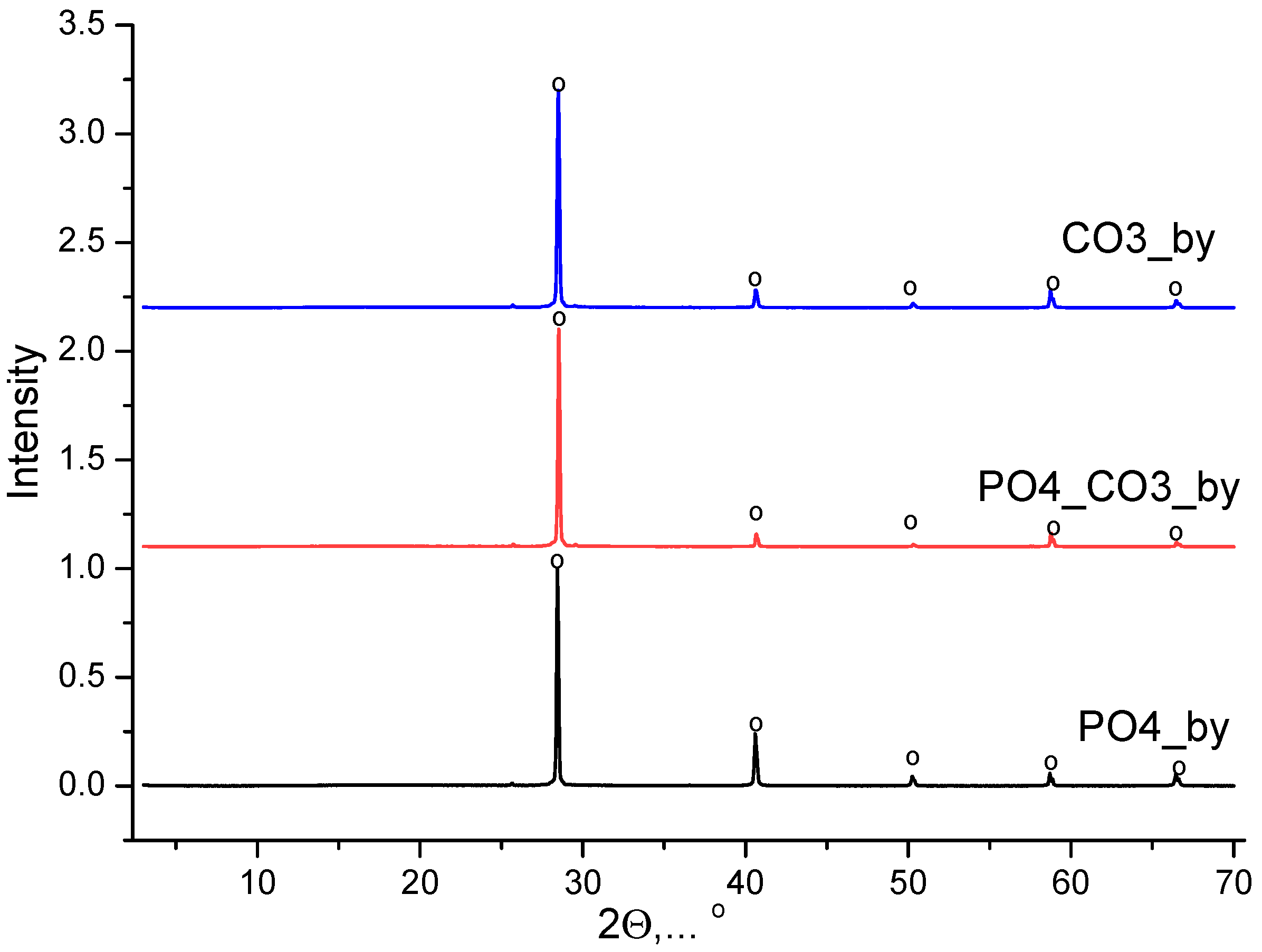
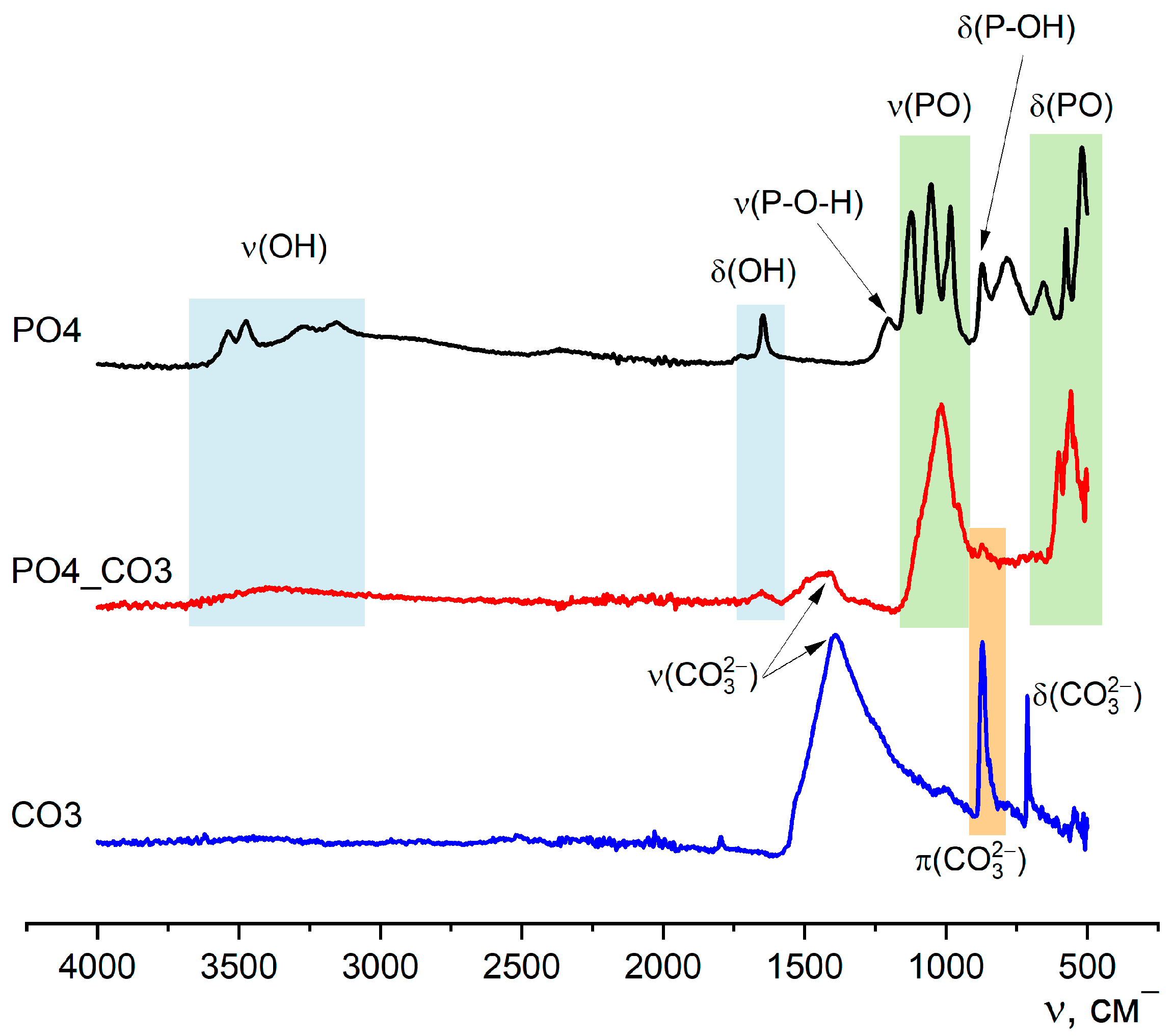
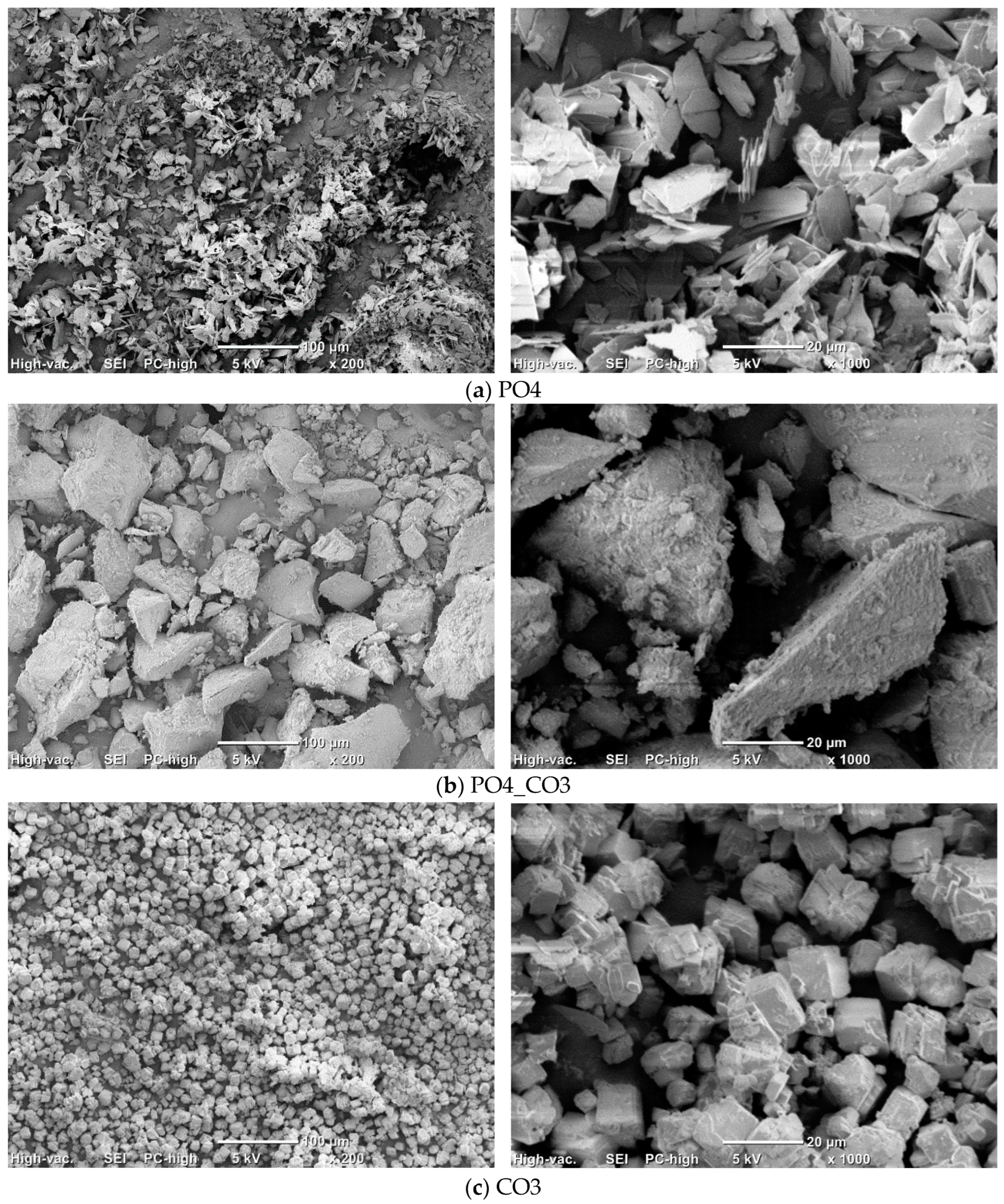
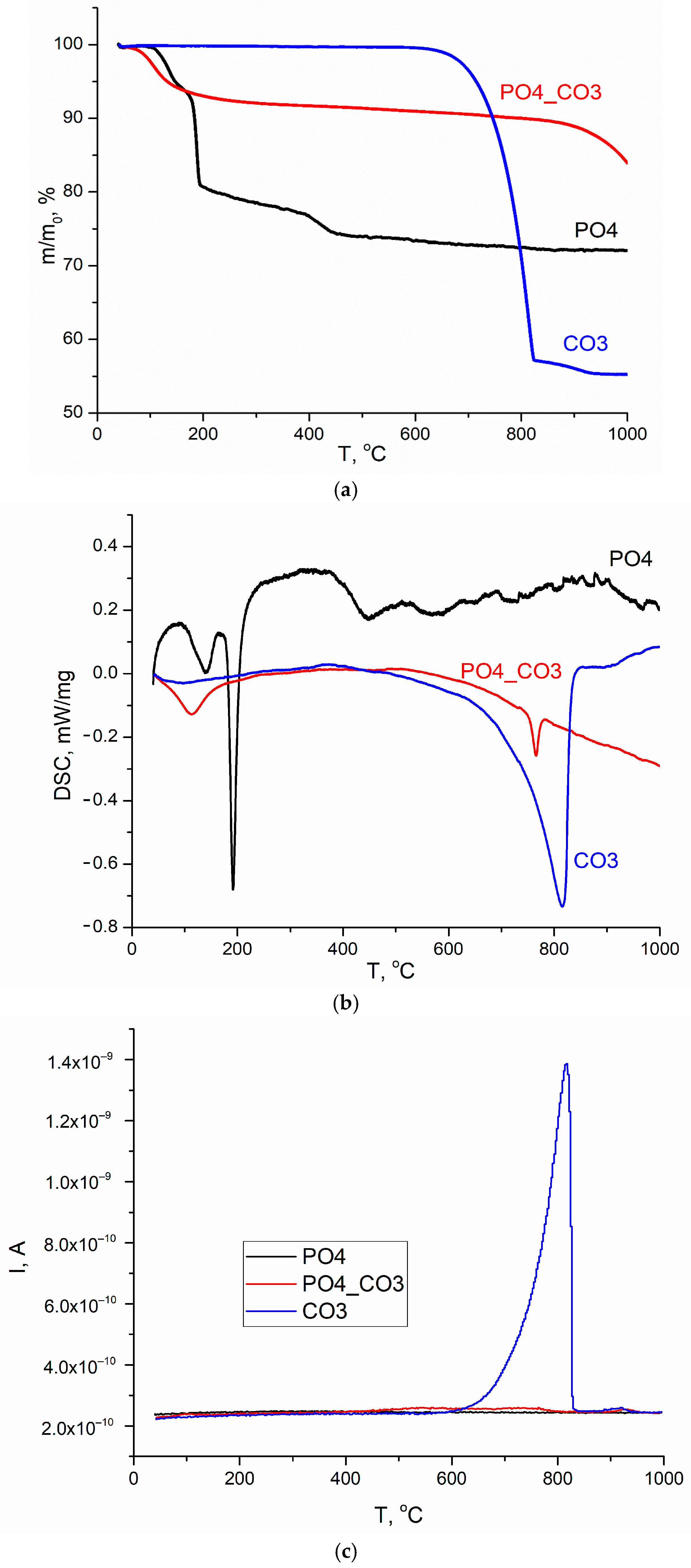


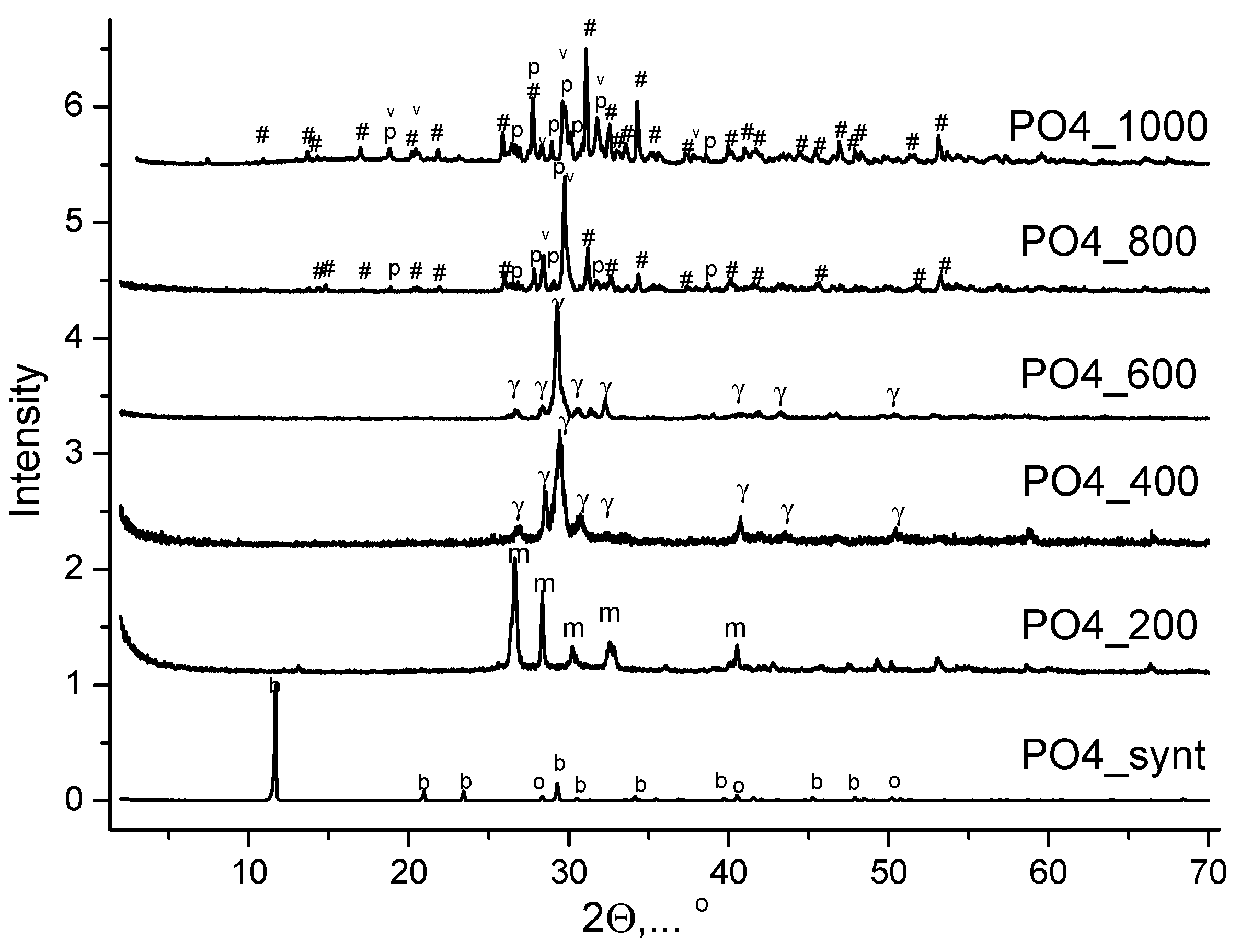
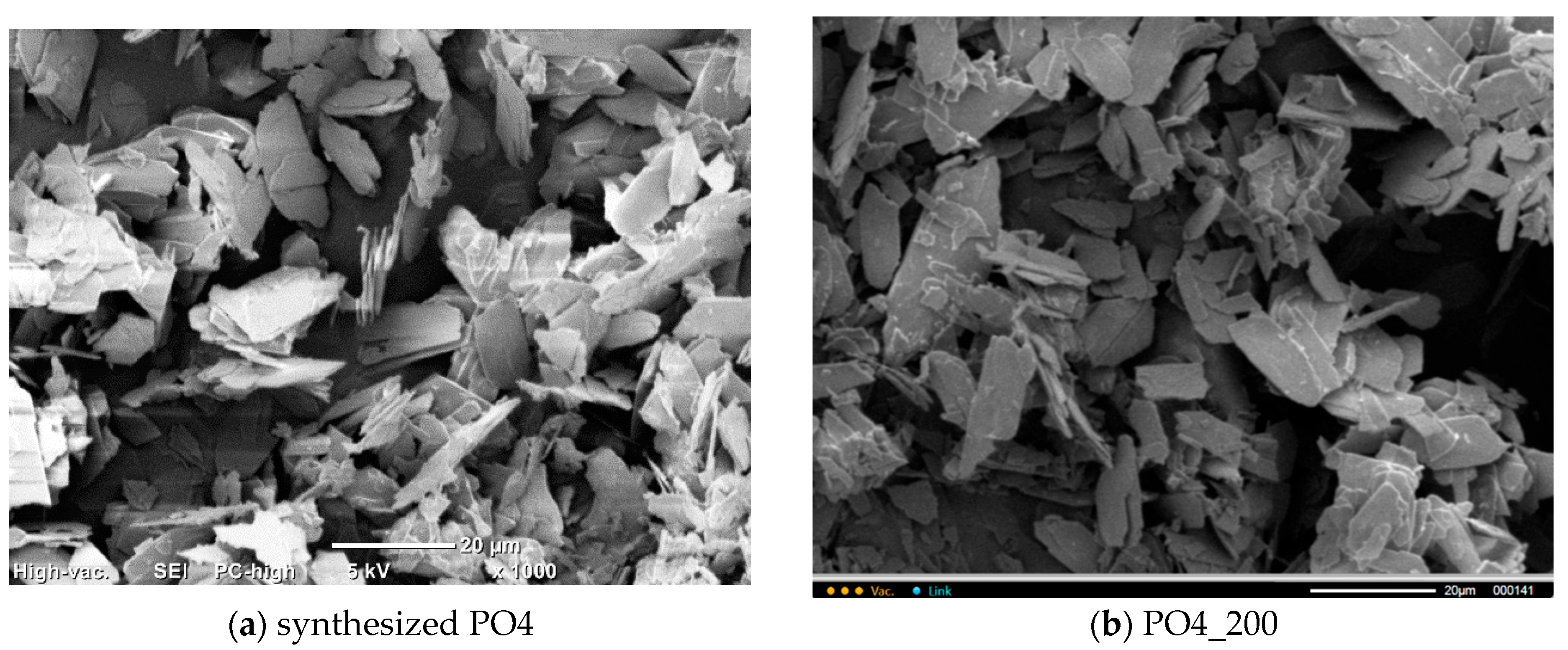
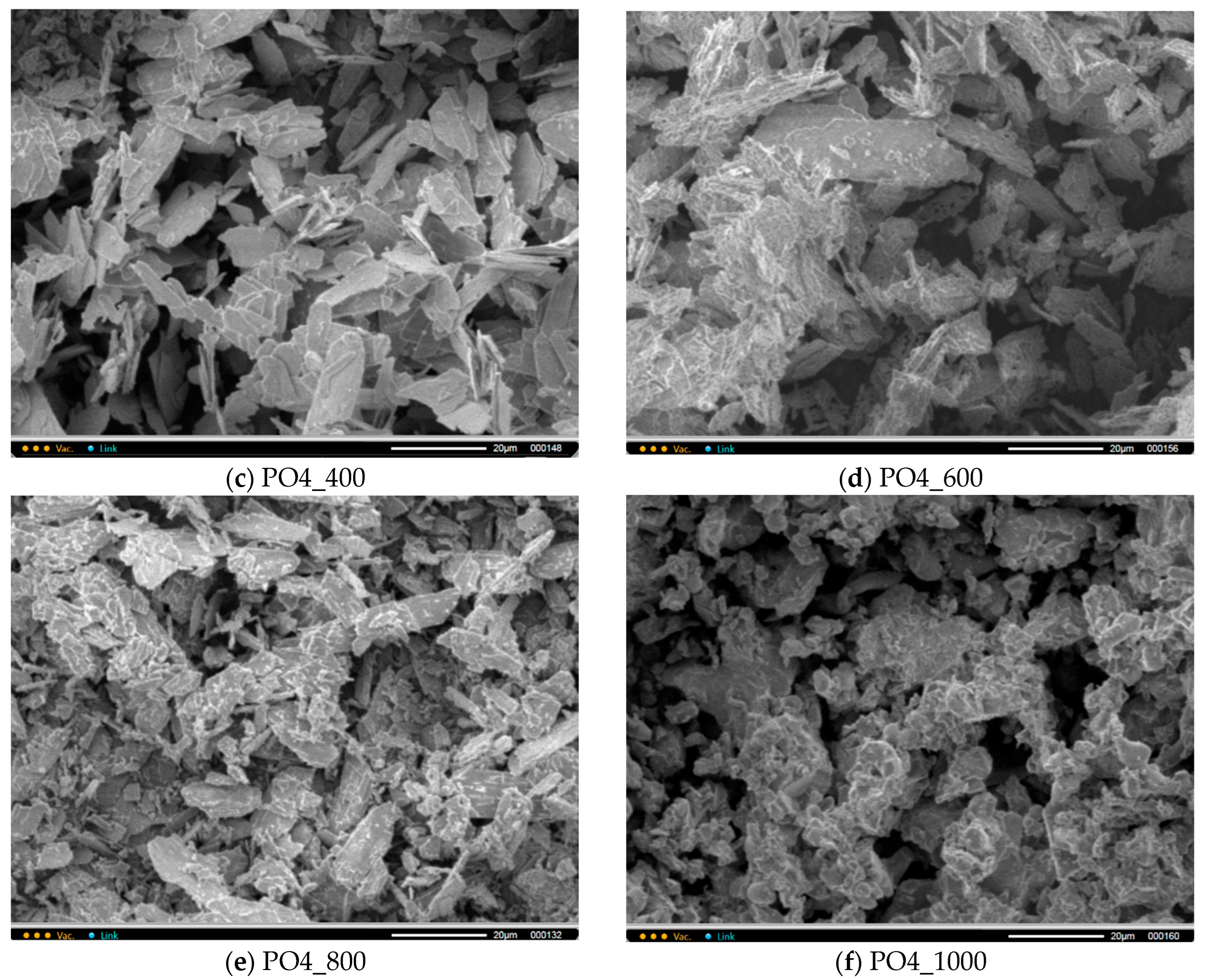
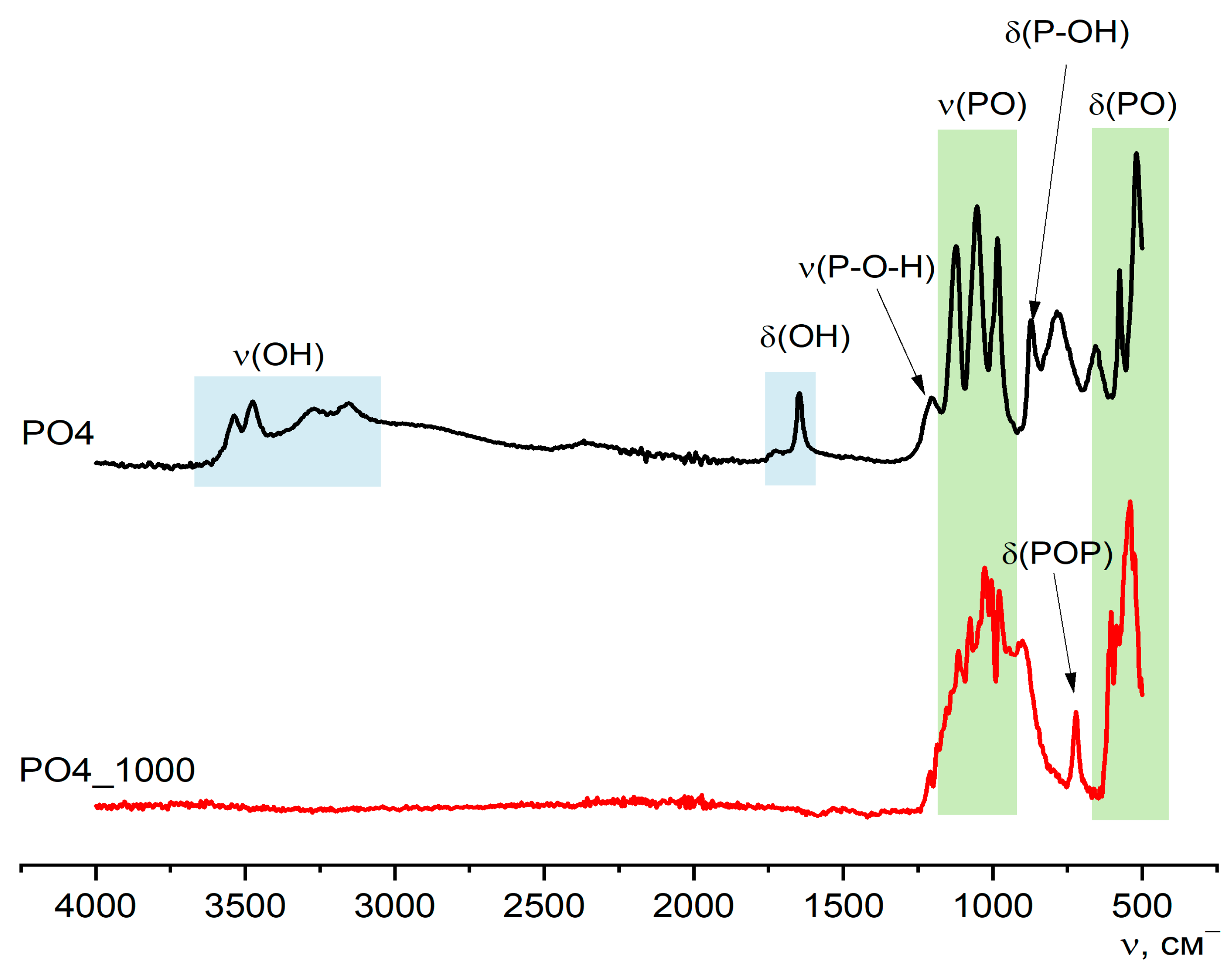
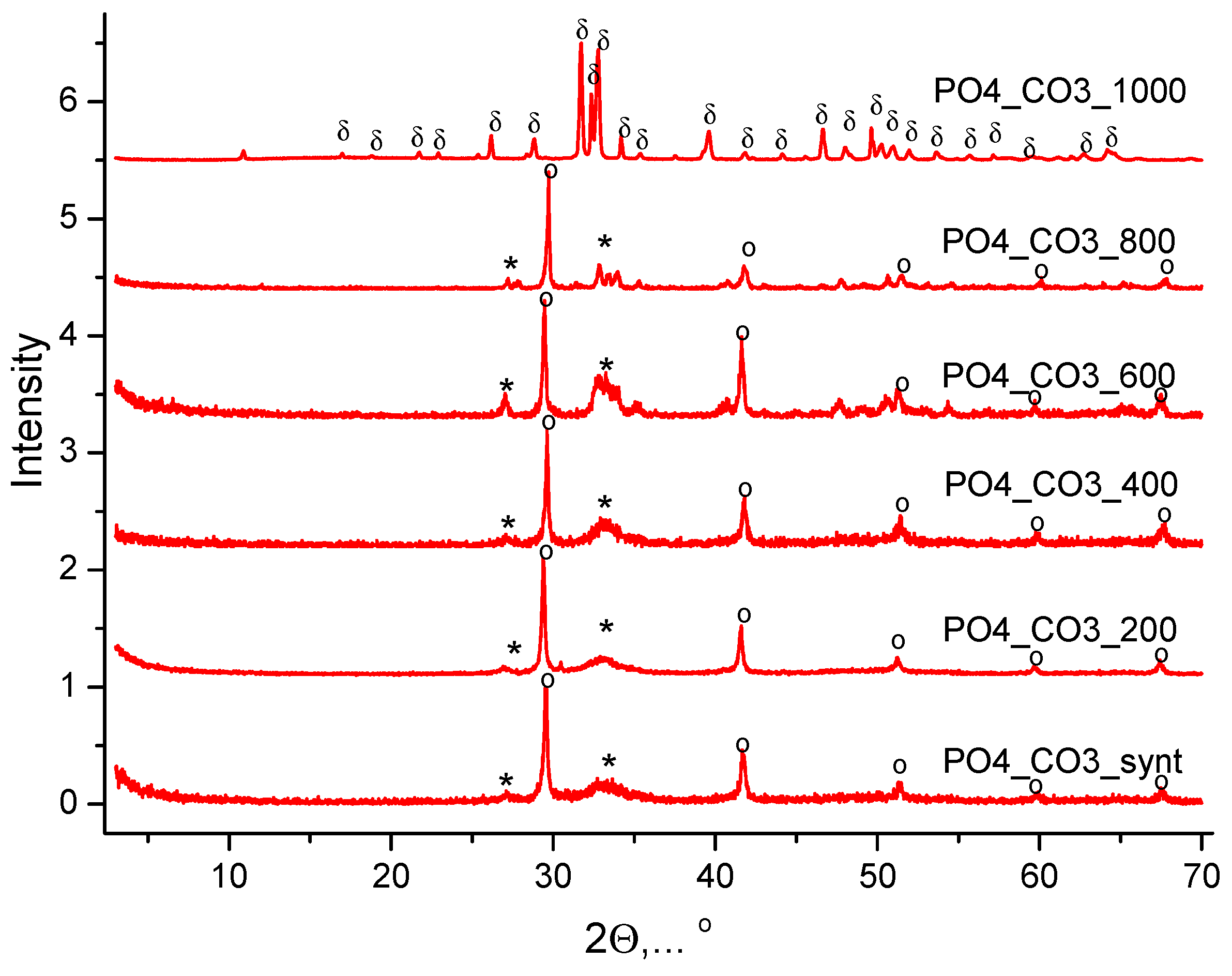
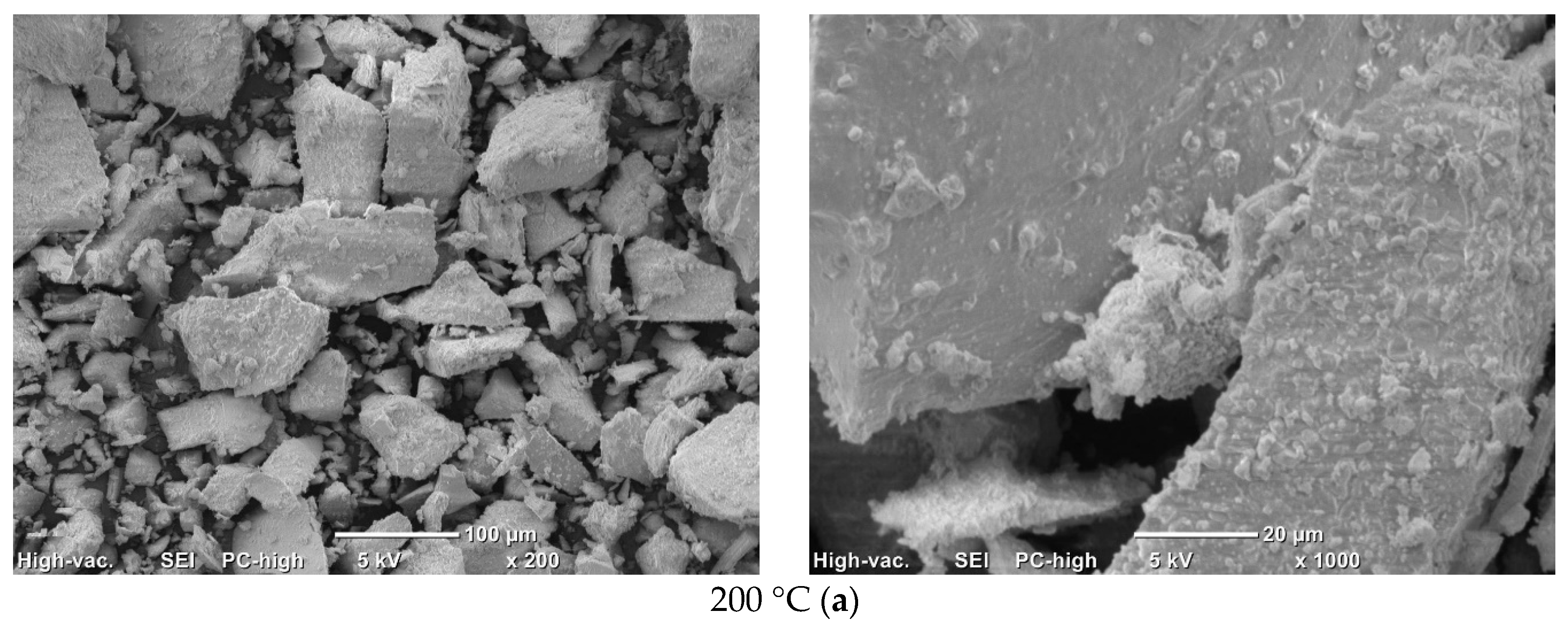
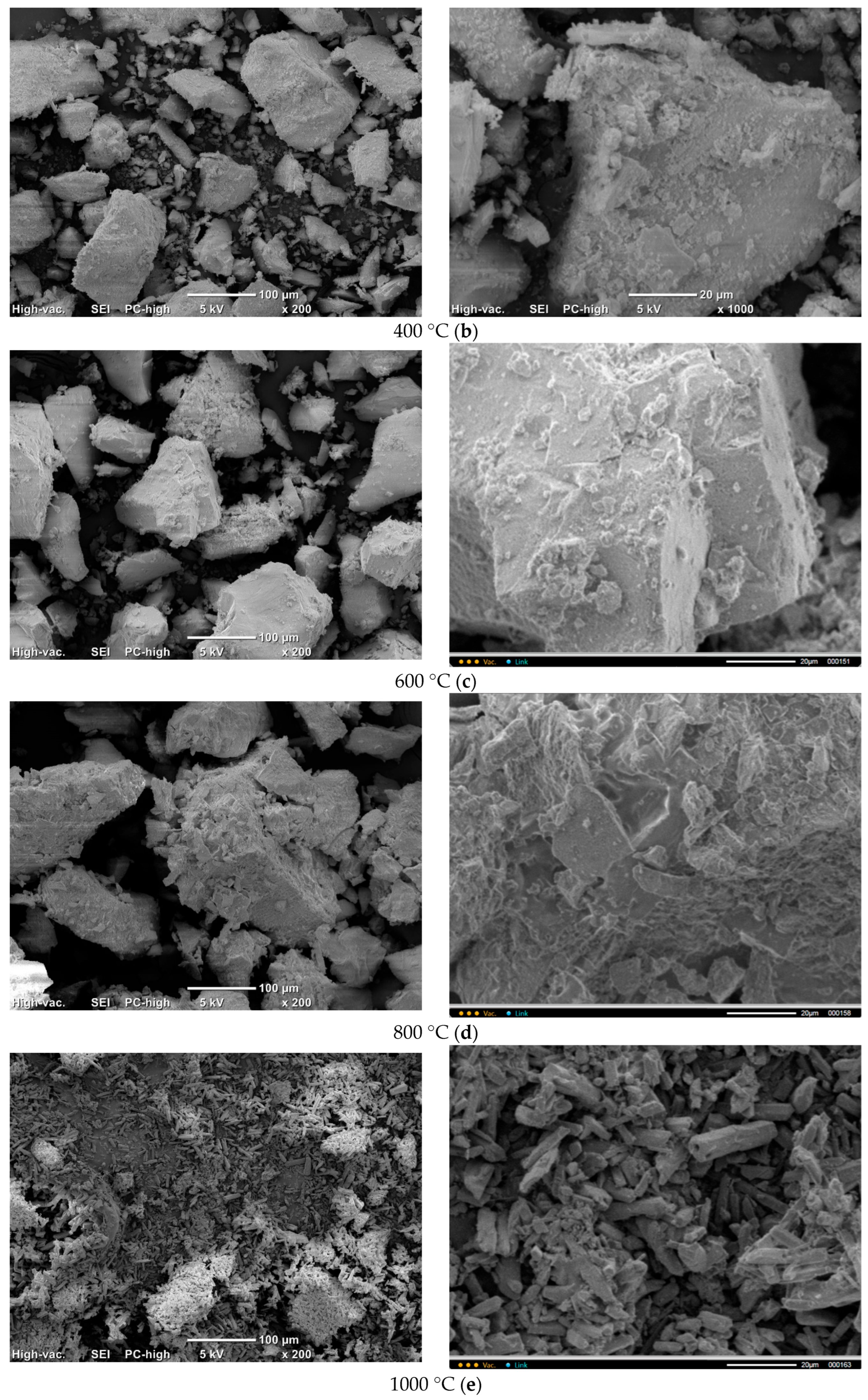
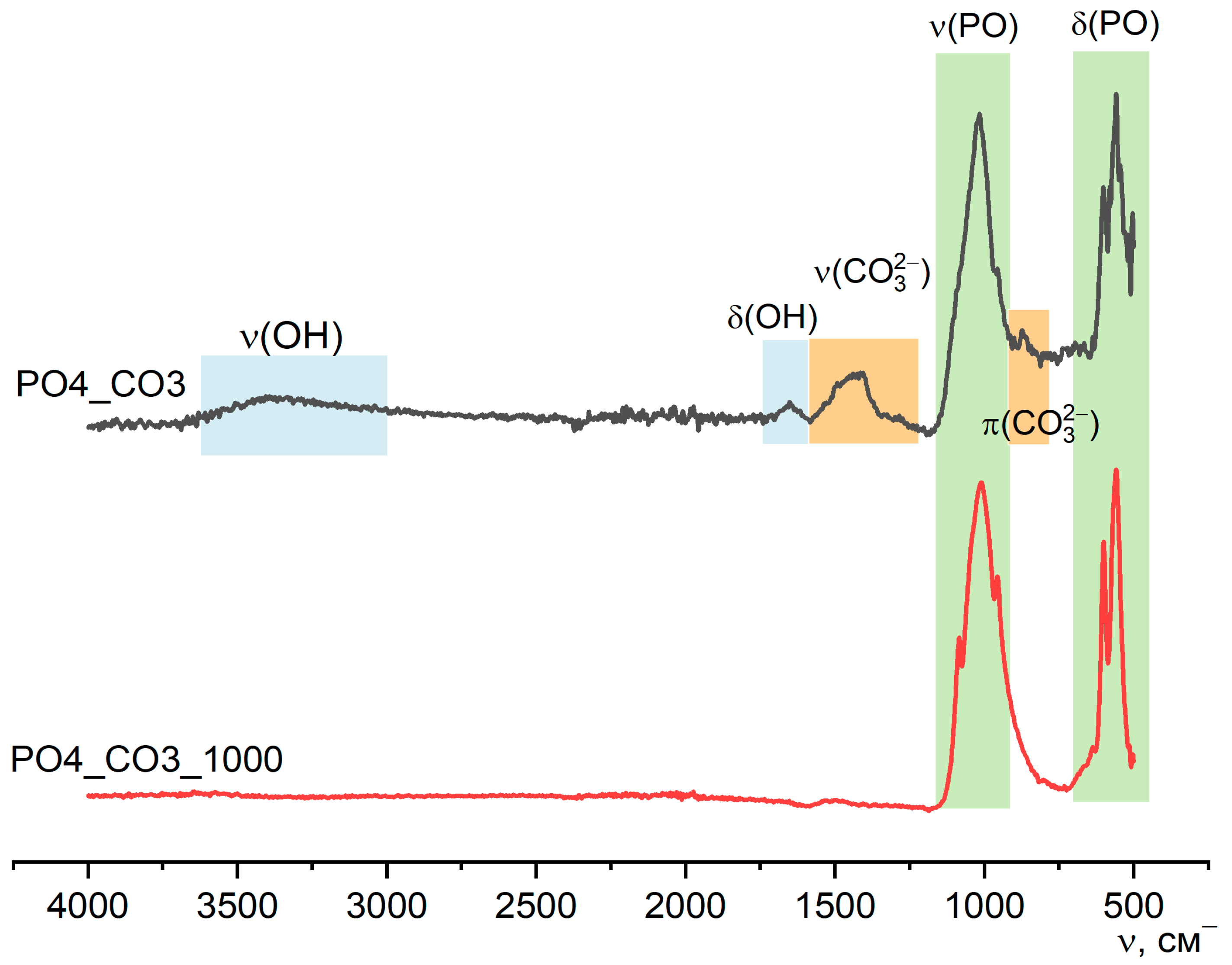
| Labeling of Powders | PO4 | PO4_CO3 | CO3 |
|---|---|---|---|
| The molar ratio of Ca/(HPO42− + CO32−) | 1 | 1 | 1 |
| CaCl2, mol | 0.25 | 0.25 | 0.25 |
| V of solution CaCl2, L | 0.5 | 0.5 | 0.5 |
| C (CaCl2), mol/L | 0.5 | 0.5 | 0.5 |
| K2HPO4·3H2O, mol | 0.25 | 0.125 | - |
| K2CO3, мoль | - | 0.125 | 0.25 |
| V of solution, containing anions (HPO42−) and/or (CO32−), L | 0.5 | 0.5 | 0.5 |
| C(K2HPO4·3H2O), mol/L | 0.5 | 0.25 | - |
| C(K2CO3), mol/L | - | 0.25 | 0.5 |
| Reagents/Products | Labeling of Synthesized Powders | ||
| PO4 | PO4_CO3 | CO3 | |
| Starting Reagents | |||
| CaCl2, mol | 0.25 | 0.25 | 0.25 |
| K2HPO4·3H2O, mol | 0.25 | 0.125 | - |
| K2CO3, mol | - | 0.125 | 0.25 |
| Target products | |||
| CaHPO4·2H2O, mol | 0.25 | 0.125 | - |
| Mass of CaHPO4·2H2O, g | 43.0 | 21.5 | - |
| CaCO3, mol | - | 0.125 | 0.25 |
| Mass of CaCO3, g | - | 12.5 | 25.0 |
| By-product | Labeling of by-products | ||
| PO4_by | PO4_CO3_by | CO3_by | |
| KCl, mol | 0.5 | 0.5 | 0.5 |
| Mass of KCl, г | 37.3 | 37.3 | 37.3 |
| Total mass of expected products * | 80.3 | 73.1 | 62.3 |
| Temperature of Heat Treatment | Labeling of Synthesized Powders | ||
|---|---|---|---|
| PO4 | PO4_CO3 | CO3 | |
| 200 °C | PO4_200 | PO4_CO3_200 | CO3_200 |
| 400 °C | PO4_400 | PO4_CO3_400 | CO3_400 |
| 600 °C | PO4_600 | PO4_CO3_600 | CO3_600 |
| 800 °C | PO4_800 | PO4_CO3_800 | CO3_800 |
| 1000 °C | PO4_1000 | PO4_CO3_1000 | - |
| Labeling | PO4 | PO4_CO3 | CO3 |
|---|---|---|---|
| The expected quantities of target products and by-product: | |||
| CaHPO4·2H2O, g | 43.0 | - | - |
| Ca10(PO4)6(OH)2 + CaCO3, g | - | 25.1 | - |
| CaCO3, g | - | - | 25.0 |
| KCl, g | 37.3 | 37.3 | 37.3 |
| Total mass of expected products *, g | 80.3 | 62.4 | 62.3 |
| The obtained masses of the synthesized powders and the extracted by-products: | |||
| Mass of the powders after drying, g | 43.0 | 33.5 | 17.4 |
| Mass of the extracted reaction by-product, g | 30.6 | 25.5 | 37.1 |
| Total mass of prepared products **, g | 73.6 | 59.0 | 54.5 |
| The yield of synthesized products | 91.7% | 94.5% | 87.5% |
| The yield of reaction by-product | 82.0% | 68.4% | 99.4% |
| Mass of by-product, preserved by precipitate (estimation), g | 6.7 | 11.8 | 0.2 |
| Content of by-product in powders (estimation) | 15.6% | 35.2% | 1.1% |
| Content of by-product in powders (estimation according to Match!) | 2.8% | 30.9% | 1.8% |
Disclaimer/Publisher’s Note: The statements, opinions and data contained in all publications are solely those of the individual author(s) and contributor(s) and not of MDPI and/or the editor(s). MDPI and/or the editor(s) disclaim responsibility for any injury to people or property resulting from any ideas, methods, instructions or products referred to in the content. |
© 2025 by the authors. Licensee MDPI, Basel, Switzerland. This article is an open access article distributed under the terms and conditions of the Creative Commons Attribution (CC BY) license (https://creativecommons.org/licenses/by/4.0/).
Share and Cite
Safronova, T.V.; Le, H.M.N.; Shatalova, T.B.; Murashko, A.M.; Filippova, T.V.; Motorin, E.A.; Tsymbarenko, D.M.; Golubchikov, D.O.; Boytsova, O.V.; Knotko, A.V. Powders Synthesized from Calcium Chloride and Mixed-Anionic Solution Containing Orthophosphate and Carbonate Ions. Compounds 2025, 5, 41. https://doi.org/10.3390/compounds5040041
Safronova TV, Le HMN, Shatalova TB, Murashko AM, Filippova TV, Motorin EA, Tsymbarenko DM, Golubchikov DO, Boytsova OV, Knotko AV. Powders Synthesized from Calcium Chloride and Mixed-Anionic Solution Containing Orthophosphate and Carbonate Ions. Compounds. 2025; 5(4):41. https://doi.org/10.3390/compounds5040041
Chicago/Turabian StyleSafronova, Tatiana V., Hieu Minh Ngoc Le, Tatiana B. Shatalova, Albina M. Murashko, Tatiana V. Filippova, Egor A. Motorin, Dmitry M. Tsymbarenko, Daniil O. Golubchikov, Olga V. Boytsova, and Alexander V. Knotko. 2025. "Powders Synthesized from Calcium Chloride and Mixed-Anionic Solution Containing Orthophosphate and Carbonate Ions" Compounds 5, no. 4: 41. https://doi.org/10.3390/compounds5040041
APA StyleSafronova, T. V., Le, H. M. N., Shatalova, T. B., Murashko, A. M., Filippova, T. V., Motorin, E. A., Tsymbarenko, D. M., Golubchikov, D. O., Boytsova, O. V., & Knotko, A. V. (2025). Powders Synthesized from Calcium Chloride and Mixed-Anionic Solution Containing Orthophosphate and Carbonate Ions. Compounds, 5(4), 41. https://doi.org/10.3390/compounds5040041







